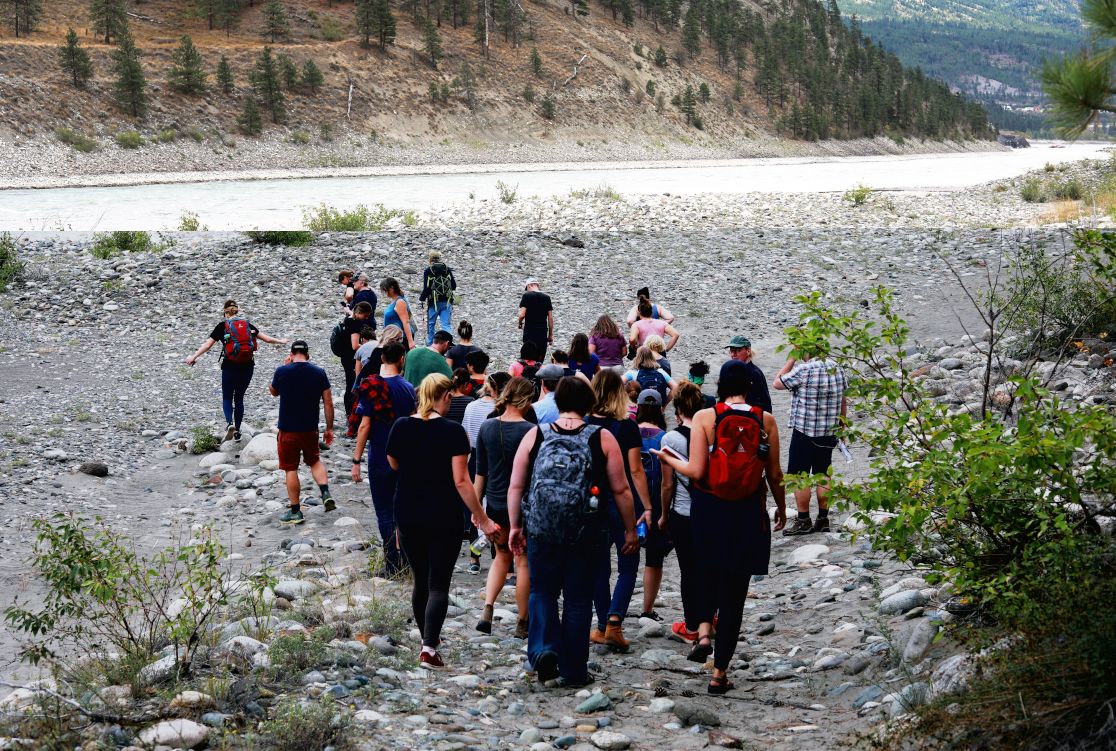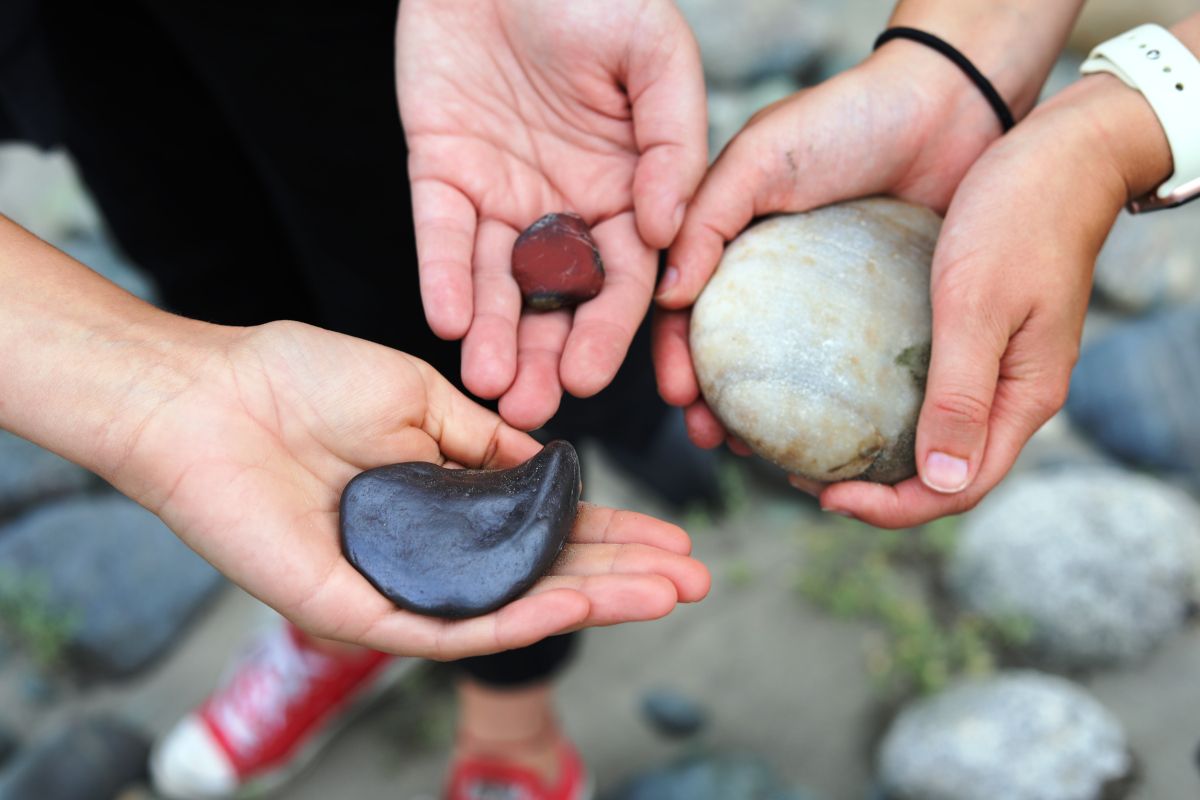In September 2019, two instructors from the Faculty of Education at Vancouver Island University—Paula Waatainen and Teresa Farrell— took 35 pre-service teachers for three days of fieldwork in the Fraser Canyon in British Columbia to further and deepen their understanding of place-based education (PBE). Students were welcomed to the territory by Elders, explored placer mining sites, hiked trails used by Indigenous Peoples since time immemorial, and were brought into a Nlaka’pamux traditional pit house. We rafted on the Fraser River through the rapids of Hell’s Gate and along quieter stretches where we saw the drying racks of Indigenous fishers. We stopped at a sand bar and heard the story of how history held its breath in 1858 to see if war would break out between the Nlaka’pamux Nation and the gold miners.
 The redesigned BC curriculum, similarly to other provinces, encourages instruction that provides opportunities for place-based learning experiences, as this allows for differentiated experiential learning (Building Student Success: BC’s New Curriculum). As recommended by the Commission in the Truth and Reconciliation Calls to Action 2015, teachers are encouraged to integrate Indigenous knowledge and teaching methods (# 62 ii) into their instruction. Place-based learning provides opportunities to make these connections. With the advent of our current pandemic, it is also safe to assume that place-based education will be encouraged, as learning outside is safer. It is pertinent and timely to explore the potential of this educational pedagogy.
The redesigned BC curriculum, similarly to other provinces, encourages instruction that provides opportunities for place-based learning experiences, as this allows for differentiated experiential learning (Building Student Success: BC’s New Curriculum). As recommended by the Commission in the Truth and Reconciliation Calls to Action 2015, teachers are encouraged to integrate Indigenous knowledge and teaching methods (# 62 ii) into their instruction. Place-based learning provides opportunities to make these connections. With the advent of our current pandemic, it is also safe to assume that place-based education will be encouraged, as learning outside is safer. It is pertinent and timely to explore the potential of this educational pedagogy.
As part of the data analysis of the fieldwork, nine concrete implementation suggestions to create meaningful place-based experiences for teachers were identified. Each suggestion below also includes quotes from the focus group participants.
Why go? Just go!
The most common responses from the focus group were similar to what is shared from K to 12 students: students like getting out of the classroom. It is fun and exciting, and it appeals to a variety of learners. It is an opportunity to experience something new and a chance to be with peers and build community in a different context.
One of my favourite things was being able to bond with everyone.
The less stand and talk the better.
A common mistake made in PBE is that we simply take the lecture to the place connected with the learning. It is far more powerful if students are actively engaged.
Sometimes it is interesting to be in a place but we are sometimes still listening to a sage on a stage.
Moving through a space, having someone with the knowledge; all this coming at you at once—better.
PBE is an opportunity for holistic learning.
Place-based learning engages students cognitively, emotionally, and kinesthetically. This is powerful. The learning is experiential and engaging. You are learning in active relationship with place.
It sticks with you when you experience learning attached to place.
Use all five senses.
Provide opportunities and instructions for students to interact in place: touching, listening, smelling, and seeing. We had students touch things, stand and listen, breathe in.
It is more powerful because you are using all the senses. You could feel it, smell it because you were there.
I liked the first day. Putting your hand in the water. I feel like there is a very important place where tactile experiences help you to connect.
Standing on the deck and feeling the currents and hearing only the river as it transports you and your vehicles across; it is powerful.
Weave in Indigenous perspectives / knowledge / history.
Acknowledge the territory and the Indigenous People whose territory you are on. Indigenous ways of knowing are deeply rooted in place where knowledge, history, culture, and place are infused. Do not get caught in the trap of locating Indigenous People only in a pre-contact past. Connect to the present. If possible and relevant, bring in community members.
What struck me was that of course the local First Nations were the ones to “discover” the gold.
[For the Nlaka’pamux] tradition and modern technology have blended when you see them fishing.
With an Elder it is almost a spiritual connection.
Paint the picture.
Set the stage. Evoke it—describe it—imagine… picture if you will. Provide students with the context to connect to the learning in this place especially when exploring things that have happened or will happen.
Being on the river, standing on the beach and Dan asking to picture what it might have been like for people living there. These newcomers saw this as exploration but what was it like for the people who lived there? I think it would have felt like an invasion. Why wasn’t I taught THAT?
Incorporate moving, visual aids, as well as information.
Give students the necessary prior knowledge to connect to the learning. This can be done before the place-based experience but should also be carried and cued during the experience in place.
Bring resources like maps and documents with you into the context of the place.
 Point out markers in the landscape.
Point out markers in the landscape.
It is important to provide information and a lens to inform what students are experiencing.
So neat how the land can tell a story. Oh look, you can see where there was placer mining. The story of what happened way back then is still in the land.
You could tell this was a road because of the rock formations. I would never have noticed that. Being taught how to look for things.
Allow room for unstructured exploration and natural inquiry.
There can also be some unstructured time. Give some room to simply explore. This can be coupled with some leading questions and provides a balance of student-led and teacher-guided experiences. Ask questions but also let the students explore and have questions arise.
Knowing what it’s like to explore, be hands-on, is so important, so [I] suggest more moments to explore surroundings.
Letting the things that you notice lead to curiosity. [It is a} nice lead to inquiry.
Student Participant Video of the Field Work https://www.youtube.com/watch?v=tar0UoA3A Eg&feature=youtu.be
ABOUT THE AUTHORS
Dr. Teresa Farrell and Paula Waatainen
Dr. Teresa Farrell and Paula Waatainen are instructors in the Bachelor of Education program in the Faculty of Education, Vancouver Island University.
Dr. Teresa Farrell was previously a secondary Drama and Social Studies teacher. Her research interests include Indigenous Inclusion, Place-Based Learning and Theatre in Education.
Paula Waatainen taught secondary Social Studies and is a Learning Sciences Education Doctorate student at University of Calgary. Her research interests include teacher professional learning regarding authentic and experiential learning.
This work was supported by funding received from a Social Sciences and Humanities Research Council (SSHRC) Exchange Grant and a Vancouver Island University Innovate Grant.
This article is featured in Canadian Teacher Magazine’s Spring 2021 issue.












